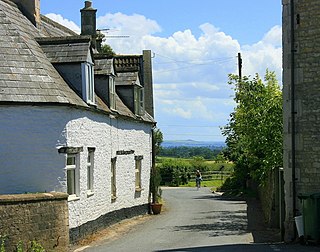
Atworth is a village and civil parish in west Wiltshire, England. The village is on the A365 road between Melksham and Box, about 2.5 miles (4 km) northwest of Melksham and 4 miles (6 km) northeast of Bradford on Avon. The hamlet of Purlpit lies east of Atworth village, and in the south of the parish are the small village of Great Chalfield and the hamlet of Little Chalfield.

St George's Church, Esher is a Grade I listed Anglican church in Esher, Surrey, England. Built in the 16th century, it was Esher's parish church for 300 years, though later worshippers included Queen Victoria. However, by the mid-19th century the building was deemed too small for the growing population, and was replaced by Christ Church, built nearby on Esher Green in 1853/4. St George's was not therefore subjected to Victorian ‘improvements’, and its Tudor origins remain evident. It is now cared for by the Churches Conservation Trust.

St. Michael's Church is an Anglican church in Brighton, England, dating from the mid-Victorian era. Located on Victoria Road in the Montpelier area, to the east of Montpelier Road, it is one of the largest churches in the city of Brighton and Hove. The church is a Grade I listed building.

St Michael and All Angels Church stands to the west of the village of Great Altcar, West Lancashire, England. The church is timber-framed and is recorded in the National Heritage List for England as a designated Grade II* listed building. It is an active Anglican parish church in the diocese of Liverpool, the archdeaconry of Liverpool and the deanery of Sefton. Its benefice is combined with that of Holy Trinity, Formby. In the Buildings of England series it is described as "an utterly charming church".

St Michael's Church is located by the side of the River Derwent in the dispersed settlement of Isel, in the civil parish of Blindcrake, Cumbria, England. It is an active Anglican parish church in the deanery of Derwent, the archdeaconry of West Cumberland, and the diocese of Carlisle. Its benefice is united with those of nine local churches to form the benefice of Binsey. The church is recorded in the National Heritage List for England as a designated Grade I listed building.

Winslade is a hamlet and civil parish in the Basingstoke and Deane district of Hampshire, England. It lies 3 miles (4.8 km) south of Basingstoke, just off the A339 road. The hamlet covers an area of 712 acres (288 ha) and has an average elevation of 550 feet (170 m). Its nearest railway station is Basingstoke, 4.2 miles (6.8 km) north of the hamlet. The parish of Winslade contains the vast Hackwood Park, an 89-acre (36 ha) Grade I listed Royal deer park. According to the 2011 census, Winslade, along with Tunworth, Weston Corbett and Weston Patrick, had a population of 224.

Hartley Wespall is a civil parish in the Basingstoke and Deane district of Hampshire, England. It is near the larger village of Hook, which lies approximately 2.5 miles (4.1 km) south-west from the hamlet.
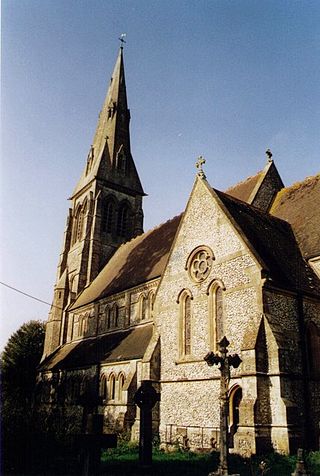
The Church of the Holy Trinity, Privett, is a redundant Anglican church in the parish of Froxfield, Hampshire. It is recorded in the National Heritage List for England as a designated Grade II* listed building, and is under the care of the Churches Conservation Trust.

St Michael's Church is a redundant Anglican church in the village of Berechurch, Essex, England. It is recorded in the National Heritage List for England as a designated Grade II* listed building, and is under the care of the Churches Conservation Trust. The church stands on the south side of Berechurch Hall Road south of the town of Colchester.
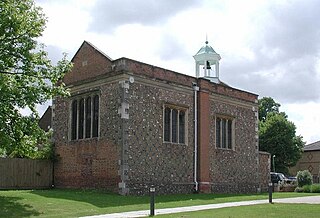
Oxhey Chapel is a redundant Anglican chapel in Oxhey, a suburb of Watford, Hertfordshire, England. It is recorded in the National Heritage List for England as a designated Grade II* listed building, and is under the care of the Churches Conservation Trust. The chapel stands, surrounded by 1940s housing in South Oxhey between a modern church and its vicarage, some 2 miles (3.2 km) south of the centre of Watford.

The Church of St John the Baptist, Upper Eldon, is a redundant Anglican church in the parish of King's Somborne, Hampshire, England. It is recorded in the National Heritage List for England as a designated Grade II* listed building, and is under the care of the Churches Conservation Trust. The church stands in the grounds of Eldon House, to the east of the A3057 road, some 4 miles (6 km) south of Stockbridge.

St Mary's Church is a redundant Anglican church in the village of Hartley Wintney, Hampshire, England. It is recorded in the National Heritage List for England as a designated Grade II* listed building, and is under the care of the Churches Conservation Trust. The church stands on a hillside to the south of the village, some 8 miles (13 km) east of Basingstoke.

Bilsham Chapel is a deconsecrated former chapel in the hamlet of Bilsham in West Sussex, England. Founded in the 13th century as a chapel of ease to the parish church of Yapton, the nearest village, the small flint building fell out of religious use around the time of the Reformation. It has subsequently been used for storage and as labourers' cottages, and since 1972 it has been a single residential property. English Heritage has listed it at Grade II for its architectural and historical importance.
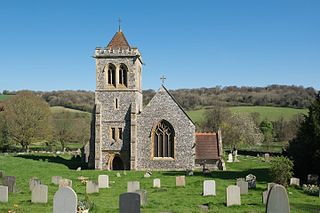
St Michael and All Angels' Church is a Grade: II* listed Anglican church in the Hughenden Valley, Buckinghamshire, England, near to High Wycombe. It is closely associated with the nearby Hughenden Manor and the former Prime Minister of the United Kingdom, Benjamin Disraeli who is buried in the churchyard.

St Michael and All Angels Church is in the village of Hawkshead, Cumbria, England. It is an active Anglican parish church in the deanery of Windermere, the archdeaconry of Westmorland and Furness, and the diocese of Carlisle. Its benefice is united with those of four local parishes to form the Benefice of Hawkshead with Low Wray and Sawrey and Rusland and Satterthwaite. The church is recorded in the National Heritage List for England as a designated Grade I listed building. Hyde and Pevsner, in the Buildings of England series, describe it as being "one of the best Lake District churches".

William Swinden Barber FRIBA, also W. S. Barber or W. Swinden Barber, was an English Gothic Revival and Arts and Crafts architect, specialising in modest but finely furnished Anglican churches, often with crenellated bell-towers. He was based in Brighouse and Halifax in the West Riding of Yorkshire. At least 15 surviving examples of his work are Grade II listed buildings, including his 1875 design for the Victoria Cross at Akroydon, Halifax. An 1864 portrait by David Wilkie Wynfield depicts him in Romantic garb, holding a flower. He served in the Artists Rifles regiment in the 1860s alongside Wynfield and other contemporary artists.
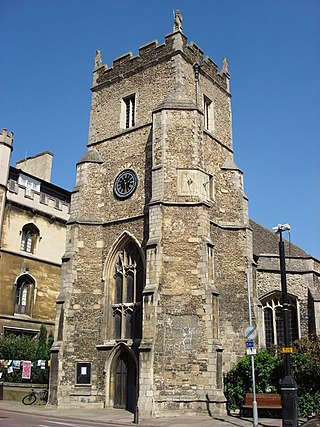
St Botolph's Church, Cambridge is a Church of England parish church in the city of Cambridge, England. The church is a Grade I listed building.

All Saints' Church, Kings Langley is a parish church in the Church of England, located in the village of Kings Langley in Hertfordshire, England. Originating in the 13th century, the church contains the tomb of Edmund of Langley (1341–1402), the first Duke of York. It is a Grade II* listed building.

Elvetham Hall is a hotel in Hampshire, England, in the parish of Hartley Wintney about 2 miles (3 km) northwest of Fleet. The building is a High Victorian Gothic Revival English country house and a Grade II* listed building. It stands in a landscaped park that is Grade II listed.

Holy Ghost Church is a Roman Catholic church in Basingstoke, Hampshire, England. It was built from 1902 to 1903 by the priest and architect Alexander Scoles in the Gothic Revival style. It was named after the old ruined medieval Chapel of the Holy Ghost in the town. It is located on the corner of Chapel Hill and Sherborne Road, north of Basingstoke railway station near the town centre. According to Historic England, the church was "the last and best work" of Alexander Scoles. He is buried there and it is a Grade II listed building.
























